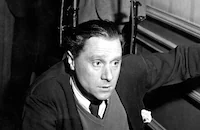Flap

Brief Synopsis
Cast & Crew
Carol Reed
Anthony Quinn
Claude Akins
Tony Bill
Victor Jory
Don Collier
Film Details
Technical Specs

Synopsis
Flap, a hard-drinking Indian who lives on an impoverished reservation in the Southwest, is in a constant state of anger over the mistreatment of his tribe. Moreover, he argues incessantly with his mistress Dorothy Bluebell, the madam of the local brothel who resents his unfaithfulness to her. Flap gets drunk one night and commandeers and destroys a bulldozer belonging to a road construction company which is encroaching on the reservation. Flap's act, intended to attract attention to the Indians' cause, results in a heated dispute between Flap and his longtime enemy, Rafferty, a halfbreed and the town's brutal police sergeant. Wounded Bear Mr. Smith, a crony of Flap's and a self-made lawyer who is an expert on Indian treaties, advises Flap that anything abandoned on an Indian reservation becomes Indian property, whereupon Flap and his friends steal a train and roll it onto the reservation, intending to claim it as Indian property. This daring act is noticed by the news services, whose representatives soon arrive at the reservation looking for Flap; but he is hiding out in the mountains, regrouping his forces for a protest march on the town. They parade down Main Street in an attempt to make people see the Indians' plight. Rafferty, in the hospital recovering from a beating he received from Flap because he maliciously caused a comrade of Flap's to suffer a fatal heart attack by cold-bloodedly shooting the man's dog, sees the protest march and from his hospital window assassinates the Indian leader as he speaks in the town square.

Director

Carol Reed
Cast

Anthony Quinn

Claude Akins

Tony Bill

Victor Jory
Don Collier

Shelley Winters
Susana Miranda
Victor French
Rodolfo Acosta

Anthony Caruso
William Mims
Rudy Diaz
Pedro Regas

J. Edward Mckinley
Robert Cleaves
John War Eagle
Crew
Bernard Abramson
Jerry Adler
Charles G. Arnold
Frank Bracht
Alan Callow
Reggie Callow
Naomi Cavin
Danny Chichester
Fred Collins
Alex D'alessio
Bobby Davenport
Carter Dehaven Jr.
Richard Doran
Milton Feldman
Marvin Hamlisch
Marvin Hamlisch
Michael Hancock
George Hause
Ann Helfgott
Clair Huffaker
Ralph S. Hurst
Fred Koenekamp
William Kronick
Estelle Levitt
Art Loel
John Monte
George Nogle
Al Overton Sr.
Jim Paisley
Mort Rabinowitz
Oscar Rodriguez
Jerry Smith
Rowland S. Smith
Charles Termini
Roy Urbach
Ron Vargas
Harold Wellman
Karen Wookey

Videos
Movie Clip



Film Details
Technical Specs

Articles
Flap
While R.P.M. had cast Quinn as a middle-aged college professor who becomes a reluctant arbiter between campus revolutionaries and university dons, Flap called upon the actor to play the revolutionary, albeit an atypical one. Based on the 1967 novel Nobody Loves a Drunken Indian, by western writer Clair Huffaker, Flap is the story of Flapping Eagle, a reservation lout whose drunken escapades are construed by others as activism and who ultimately becomes a martyr to the cause of Native American rights. The film was British producer-director Carol Reed's penultimate production and his follow-up to Oliver! (1968), his Academy Award-winning big screen adaptation of the long-running Broadway musical. As had Oliver!, Flap attends the plight of the disadvantaged - namely, the residents of a downtrodden New Mexico reservation - with a focus that is both comical and tragic but ultimately. The film had gone into production under a handful of alternate titles, among them Nobody Loves a Drunken Indian and Nobody Loves Flapping Eagle, with principal photography commencing in and around New Mexico's Santa Clara Pueblo and the ancient Puye Cliffs. Flap's supporting cast included two-time Oscar winner Shelley Winters and Tony Bill, who would soon trade acting for producer credits on such films as The Sting (1973), Hearts of the West (1975), and Going in Style (1979).
Warner Bros.' ad campaign for Flap contained the tagline "The Indians have already claimed Alcatraz... City Hall may be next!" However nonsensical the reference may be to contemporary eyes, the Warners publicity mill was referring to an event that had gained national attention. As production commenced in late 1969, members of the Native American activist group Red Power had begun what would be an almost two-year occupation of Alcatraz Island in San Francisco Bay. The siege of the declassified penitentiary was an attempt to reclaim the land for indigenous peoples, based on a stipulation in the 1868 Treaty of Fort Laramie that relinquished retired government land to the Sioux nation. Though the occupation ended ignominiously with the activists forcibly removed, the protest played a decisive role in legitimizing Native American self-determination. Flap was a box office failure for Warner Bros. but the studio fared better when it acquired Tom Laughlin's Billy Jack (1971), another chronicle of the struggle for Native American rights that went on to become one of the most successful independent films of all time.
By Richard Harland Smith
Sources:
The Films of Carol Reed by Robert F. Moss (Columbia University Press, 1987)
British Film Makers: Carol Reed by Peter William Evans (Manchester University Press, 2005)

Flap
Quotes
Trivia
Notes
Location scenes filmed in New Mexico. Prerelease titles: Nobody Loves a Drunken Indian and Nobody Loves Flapping Eagle.

Miscellaneous Notes
Released in United States November 1970
Released in United States Winter January 1, 1970
Released in United States Winter January 1, 1970
Released in United States November 1970













